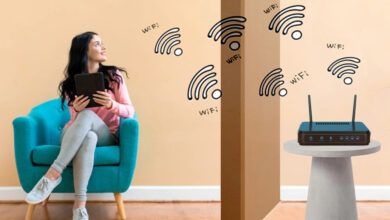How to Fix Laptop Keeps Disconnecting from WiFi?

If you’ve ever experienced your laptop continuously disconnecting from WiFi, you know how frustrating it can be. There are a variety of reasons why this issue occurs, but fortunately, there are also many solutions to fix it.
TAKEAWAY:
If your laptop keeps disconnecting from WiFi, there are several solutions to try. Updating your network drivers, disabling power-saving settings, resetting your router, changing your router’s channel, and performing a system restore can all help fix connectivity issues. If the issue persists, it’s possible that there is a hardware issue with your laptop’s wireless adapter and you may need to contact your laptop manufacturer or a professional technician for further assistance.
In this article, we’ll discuss the common reasons for this issue and provide easy-to-follow steps to troubleshoot and solve the problem.
Reasons Why Your Laptop Keeps Disconnecting from WiFi
Before we dive into the solutions, it’s essential to understand why this issue happens in the first place. Here are some common reasons why your laptop keeps disconnecting from WiFi:
1. Wireless Interference
Wireless interference from other devices can cause your laptop to disconnect from WiFi. This can include other laptops, smartphones, or even your microwave. Additionally, if you live in an apartment complex or urban area, many wireless networks could interfere with each other.
2. Outdated Network Drivers
If your laptop’s network drivers are outdated or corrupted, this can cause connectivity issues. Network drivers allow your laptop to communicate with the wireless network, and if they are outdated or corrupted, your laptop may not be able to connect or maintain a stable connection.
3. Power Saving Settings
Some laptops have power-saving settings that can interfere with the WiFi connection. These settings may cause your laptop to disconnect from WiFi after a certain amount of time to conserve power.
4. Router Issues
Sometimes, the problem may not be with your laptop but with your router. The router could be outdated or malfunctioning, causing connectivity issues.
Now that we have a better understanding of why this issue occurs let’s move onto the solutions.
Solutions to Fix Laptop Keeps Disconnecting from WiFi
1. Move Your Laptop Closer to the Router
One simple solution to this problem is to move your laptop closer to the router. This will help reduce wireless interference and improve the strength of the WiFi signal.
2. Update Your Network Drivers
To fix outdated or corrupted network drivers, you’ll need to update them. You can do this manually by going to your laptop manufacturer’s website and downloading the latest drivers for your wireless adapter. Alternatively, you can use a driver updater tool to automatically update your drivers.
3. Disable Power Saving Settings
To disable power-saving settings, follow these steps:
- Go to Control Panel
- Click on Hardware and Sound
- Click on Power Options
- Click on Change Plan Settings next to your current power plan
- Click on Change Advanced Power Settings
- Expand Wireless Adapter Settings
- Expand Power Saving Mode
- Change the setting to Maximum Performance
- Click Apply and then OK
4. Reset Your Router
If you suspect that your router is the issue, you can try resetting it. To reset your router, follow these steps:
- Locate the reset button on your router
- Press and hold the button for at least 10 seconds
- Wait for the router to restart
5. Use a WiFi Analyzer
A WiFi analyzer can help identify wireless interference and signal strength. You can download a WiFi analyzer app on your smartphone or use a desktop app to scan your network. Once you’ve identified any issues, you can take steps to reduce interference and improve signal strength.
6. Change Your Router’s Channel
Your router may be using a crowded channel, causing interference with other networks. By changing the channel, you can potentially reduce interference and improve connectivity. To change your router’s channel, follow these steps:
- Log into your router’s web interface
- Look for the channel settings in the wireless settings section
- Change the channel to one that is less crowded
7. Update Your Router Firmware
Outdated router firmware can also cause connectivity issues. Check your router manufacturer’s website for any firmware updates and follow their instructions to update your router’s firmware.
8. Disable IPv6
Disabling IPv6 can sometimes improve connectivity issues. Here’s how to disable IPv6 on your laptop:
- Go to Control Panel
- Click on Network and Sharing Center
- Click on Change adapter settings
- Right-click on your wireless network adapter and select Properties
- Uncheck the box next to Internet Protocol Version 6 (TCP/IPv6)
- Click OK to save changes
9. Disable Firewall or Antivirus Software
In some cases, your firewall or antivirus software may be blocking your WiFi connection. Try temporarily disabling these programs to see if it improves your connectivity issues. Make sure to re-enable them after testing.
10. Perform a System Restore
If you’ve tried all the above solutions and still have connectivity issues, you can try performing a system restore. A system restore will revert your laptop to an earlier state when it was functioning correctly. Follow these steps to perform a system restore:
- Go to Control Panel
- Click on System and Security
- Click on System
- Click on System Protection
- Click on System Restore
- Choose a restore point from a time when your laptop was functioning correctly
- Follow the prompts to complete the system restore process
By following these solutions, you should be able to fix your laptop’s connectivity issues. If you’re still experiencing issues, it’s possible that there is a hardware issue with your laptop’s wireless adapter. In this case, you may need to contact your laptop manufacturer or a professional technician for further assistance.
FAQ: How To Fix Laptop Keeps Disconnecting From WiFi?
1. Fix WiFi Keeps Disconnecting On Windows 10
If you’re experiencing WiFi connectivity issues on your Windows 10 laptop, there are several solutions to try. First, ensure that your laptop’s network drivers are up to date. Outdated or corrupted network drivers can cause connectivity issues. You can manually update your drivers by going to your laptop manufacturer’s website and downloading the latest drivers for your wireless adapter. Alternatively, you can use a driver updater tool to automatically update your drivers.
Another solution is to disable power-saving settings. Some laptops have power-saving settings that can interfere with the WiFi connection. These settings may cause your laptop to disconnect from WiFi after a certain amount of time to conserve power. To disable power-saving settings, go to Control Panel > Hardware and Sound > Power Options > Change Plan Settings > Change Advanced Power Settings > Expand Wireless Adapter Settings > Expand Power Saving Mode > Change the setting to Maximum Performance > Click Apply and then OK.
You can also try resetting your router or changing your router’s channel to reduce wireless interference. Additionally, performing a system restore may help if you’ve tried all the above solutions and still have connectivity issues.
2. Why is my WiFi keep disconnecting Windows 10?
There are several reasons why your WiFi keeps disconnecting on Windows 10. One common reason is outdated or corrupted network drivers. Network drivers allow your laptop to communicate with the wireless network, and if they are outdated or corrupted, your laptop may not be able to connect or maintain a stable connection.
Another reason could be wireless interference from other devices. This can include other laptops, smartphones, or even your microwave. Additionally, if you live in an apartment complex or urban area, many wireless networks could interfere with each other.
Power-saving settings can also interfere with the WiFi connection. These settings may cause your laptop to disconnect from WiFi after a certain amount of time to conserve power. Finally, your router may be the issue. The router could be outdated or malfunctioning, causing connectivity issues.
3. Why does my WiFi keep disconnecting on my computer?
If your WiFi keeps disconnecting on your computer, there are several solutions to try. First, ensure that your computer’s network drivers are up to date. Outdated or corrupted network drivers can cause connectivity issues. You can manually update your drivers by going to your computer manufacturer’s website and downloading the latest drivers for your wireless adapter. Alternatively, you can use a driver updater tool to automatically update your drivers.
Another solution is to disable power-saving settings. Some computers have power-saving settings that can interfere with the WiFi connection. These settings may cause your computer to disconnect from WiFi after a certain amount of time to conserve power. To disable power-saving settings, go to Control Panel > Hardware and Sound > Power Options > Change Plan Settings > Change Advanced Power Settings > Expand Wireless Adapter Settings > Expand Power Saving Mode > Change the setting to Maximum Performance > Click Apply and then OK.
You can also try resetting your router or changing your router’s channel to reduce wireless interference. Additionally, performing a system restore may help if you’ve tried all the above solutions and still have connectivity issues.
4. How do I stop my laptop from disconnecting from my WiFi?
If you want to stop your laptop from disconnecting from WiFi, there are several solutions to try. First, ensure that your laptop’s network drivers are up to date. Outdated or corrupted network drivers can cause connectivity issues. You can manually update your drivers by going to your laptop manufacturer’s website and downloading the latest drivers for your wireless adapter. Alternatively, you can use a driver updater tool to automatically update your drivers.
Another solution is to disable power-saving settings. Some laptops have power-saving settings that can interfere with the WiFi connection. These settings may cause your laptop to disconnect from WiFi after a certain amount of time to conserve power. To disable power-saving settings, go to Control Panel > Hardware and Sound > Power Options > Change Plan Settings > Change Advanced Power Settings > Expand Wireless Adapter Settings > Expand Power Saving Mode > Change the setting to Maximum Performance > Click Apply and then OK.
You can also try moving your laptop closer to the router to reduce wireless interference and improve the strength of the WiFi signal. Additionally, resetting your router or changing your router’s channel may help reduce interference and improve connectivity. Finally, you may need to contact your laptop manufacturer or a professional technician if the issue persists.
5. Why does my WiFi keep disconnecting again and again?
If your WiFi keeps disconnecting again and again, it could be due to several reasons. One common reason is outdated or corrupted network drivers. Network drivers allow your device to communicate with the wireless network, and if they are outdated or corrupted, your device may not be able to connect or maintain a stable connection.
Another reason could be wireless interference from other devices. This can include other laptops, smartphones, or even your microwave. Additionally, if you live in an apartment complex or urban area, many wireless networks could interfere with each other.
Power-saving settings can also interfere with the WiFi connection. These settings may cause your device to disconnect from WiFi after a certain amount of time to conserve power. Finally, your router may be the issue. The router could be outdated or malfunctioning, causing connectivity issues.
6. Why does my HP laptop not stay connected to WiFi?
If your HP laptop is not staying connected to WiFi, there are several solutions to try. First, ensure that your laptop’s network drivers are up to date. Outdated or corrupted network drivers can cause connectivity issues. You can manually update your drivers by going to HP’s website and downloading the latest drivers for your wireless adapter. Alternatively, you can use a driver updater tool to automatically update your drivers.
Another solution is to disable power-saving settings. Some laptops have power-saving settings that can interfere with the WiFi connection. These settings may cause your laptop to disconnect from WiFi after a certain amount of time to conserve power. To disable power-saving settings, go to Control Panel > Hardware and Sound > Power Options > Change Plan Settings > Change Advanced Power Settings > Expand Wireless Adapter Settings > Expand Power Saving Mode > Change the setting to Maximum Performance > Click Apply and then OK.
You can also try resetting your router or changing your router’s channel to reduce wireless interference. Additionally, performing a system restore may help if you’ve tried all the above solutions and still have connectivity issues.
7. Why does my HP laptop keep losing WiFi connection?
If your HP laptop keeps losing WiFi connection, there are several solutions to try. First, ensure that your laptop’s network drivers are up to date. Outdated or corrupted network drivers can cause connectivity issues. You can manually update your drivers by going to HP’s website and downloading the latest drivers for your wireless adapter. Alternatively, you can use a driver updater tool to automatically update your drivers.
Another solution is to disable power-saving settings. Some laptops have power-saving settings that can interfere with the WiFi connection. These settings may cause your laptop to disconnect from WiFi after a certain amount of time to conserve power. To disable power-saving settings, go to Control Panel > Hardware and Sound > Power Options > Change Plan Settings > Change Advanced Power Settings > Expand Wireless Adapter Settings > Expand Power Saving Mode > Change the setting to Maximum Performance > Click Apply and then OK.
You can also try resetting your router or changing your router’s channel to reduce wireless interference. Additionally, performing a system restore may help if you’ve tried all the above solutions and still have connectivity issues.
8. Why does my WiFi keep disconnecting on my laptop Windows 11
If your WiFi keeps disconnecting on your laptop running Windows 11, there are several solutions to try. First, ensure that your laptop’s network drivers are up to date. Outdated or corrupted network drivers can cause connectivity issues. You can manually update your drivers by going to your laptop manufacturer’s website and downloading the latest drivers for your wireless adapter. Alternatively, you can use a driver updater tool to automatically update your drivers.
Another solution is to disable power-saving settings. Some laptops have power-saving settings that can interfere with the WiFi connection. These settings may cause your laptop to disconnect from WiFi after a certain amount of time to conserve power. To disable power-saving settings, go to Control Panel > Hardware and Sound > Power Options > Change Plan Settings > Change Advanced Power Settings > Expand Wireless Adapter Settings > Expand Power Saving Mode > Change the setting to Maximum Performance > Click Apply and then OK.
You can also try resetting your router or changing your router’s channel to reduce wireless interference. Additionally, performing a system restore may help if you’ve tried all the above solutions and still have connectivity issues.
Another solution is to check for any Windows updates. Updating Windows can often fix connectivity issues. To check for updates, go to Settings > Update & Security > Windows Update > Check for updates.
Finally, it’s possible that there is a hardware issue with your laptop’s wireless adapter. In this case, you may need to contact your laptop manufacturer or a professional technician for further assistance.
Conclusion
Experiencing WiFi connectivity issues on your laptop can be frustrating, but there are several solutions you can try to fix the problem. By updating your network drivers, disabling power-saving settings, resetting your router, changing your router’s channel, and performing a system restore, you can often resolve connectivity issues.
It’s important to remember that these solutions should be tried one at a time, and you should test your WiFi connection after each solution to determine if it has resolved the issue. If you’re still experiencing issues, it’s possible that there is a hardware issue with your laptop’s wireless adapter, and you may need to contact your laptop manufacturer or a professional technician for further assistance. With a bit of patience and persistence, you should be able to get your laptop’s WiFi connection back up and running smoothly.




